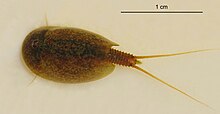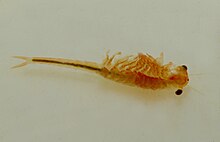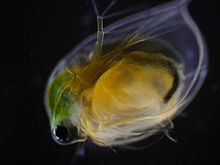Gill pods
| Gill pods | ||||||||
|---|---|---|---|---|---|---|---|---|

Triops longicaudatus (Notostraca) |
||||||||
| Systematics | ||||||||
|
||||||||
| Scientific name | ||||||||
| Branchiopoda | ||||||||
| Latreille , 1817 | ||||||||
| Orders | ||||||||
|
The leaf-pods (Phyllopoda) or gill-pods (Branchiopoda) represent a summary of the gill-pods (Anostraca), the back scarfs (Notostraca; cf. inter alia Triops ) and the clawed tails (Onychura).
The leaf crabs are typical freshwater inhabitants that originally developed from marine ancestors. Secondarily, some species have returned to the sea. Recent forms have survived mainly in relict and extreme biotopes (e.g. temporary waters , inland salt lakes ).
Arguments for a monophyly of the leaf crabs are their amoeba-like sperm, the filter apparatus formed by bristled trunk extremities and the structure of their nauplius larvae.
The trunk extremities of the leaf crabs (Branchiopoda) are originally two- branched leaf legs and thus give their name. They originally have three functions. Breathing is done by the gills (epipodites) on the outer leg base. Ingestion of food occurs first with the help of the filter apparatus, which is formed by the long-bristled leaf legs on the trunk. Adjacent leaf bones successively form temporary suction chambers. The resulting stream of water drives food particles out of the medium into the bristle crests of the leaf bones. Then further bristles located on the inner leg base guide the filtered out food particles in a ventral food channel to the mouth. The locomotion happens by metachronic kick and is combined with the described filtering food intake. The legs can be modified secondarily, especially in miniaturized forms.
The nauplius larva of the leaf crabs (Branchiopoda) has undivided antennae. There is a joint zone on the bristles of the second antennae. The mandibles are single-branched. The labrum is elongated.
The system of leaf crabs (Branchiopoda) and its subgroups are shown below.
| Leaf crabs (Branchiopoda) |
|
||||||||||||||||||||||||||||||||||||||||||
|
|


Arguments for a Monophylum Phyllopoda consisting of back scarfs ( Notostraca ) and claw tails ( Onychura ) are the storage of the complex eyes in a pocket of the head capsule (internalization) and the 4-cup nauplius eye , if the latter is a derived condition.
Arguments for a monophyly of the claw tails ( onychura ) are the secondary body-enveloping carapace , the reduction of the primary carapace to a head shield and the claw nature of the tail fork (furka).
Apomorphies are missing to justify a monophylum "Conchostraca" within the claw tails Onychura consisting of Laevicaudata and Spinicaudata . Features recognized so far have been found to be convergent.
Furthermore, the species Cyclestheria hislopii does not belong to the Spinicaudata, but forms a monophylum with the Cladocera . This is supported by the annual cycle change of parthenogenetic and bisexual generations, which occurs in both taxa, as apomorphism.
An alternative relationship hypothesis comes from Ax (1999). Then the higher crabs ( Malacostraca ) stand within the leaf crabs ( Branchiopoda) and form with them the monophylum of the Phyllopodomorpha. This alternative hypothesis gives the following system:
| Phyllopodomorpha |
|
||||||||||||||||||
|
|
literature
- P. Ax: The system of Metazoa II. A textbook of phylogenetic systematics. Gustav Fischer Verlag, 1999.
- HE Gruner: Class Crustacea. In HE Gruner (Ed.): Textbook of Special Zoology, Volume I, 4th part: Arthropoda (without Insecta). Gustav Fischer Verlag, 1993.
- HK make-up: Crustacea, crayfish. In Westheide, Rieger (Hrsg.): Special zoology part 1: single-cell and invertebrate animals. Gustav Fischer Verlag, 1997.
